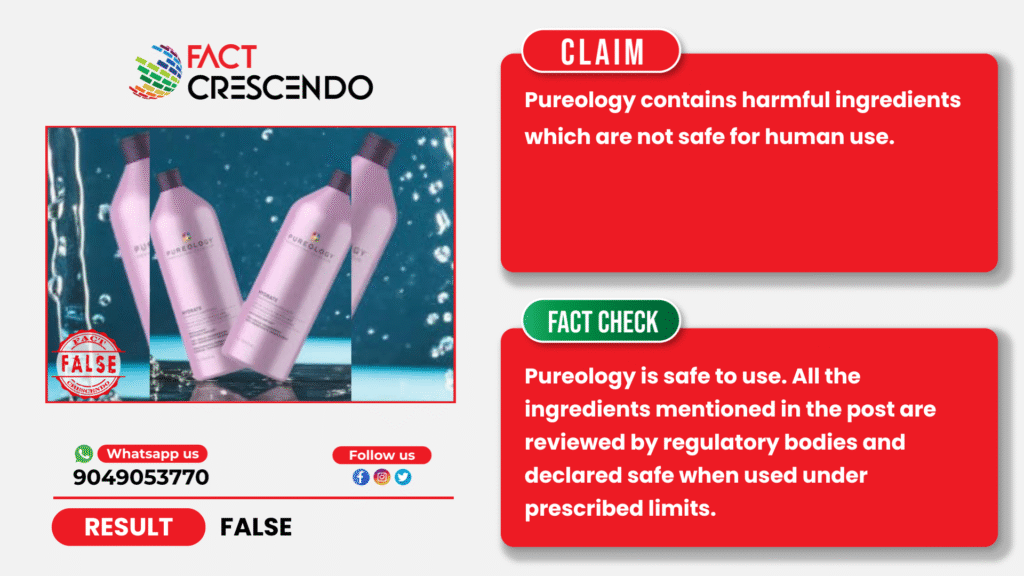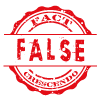
Pureology shampoo is a premium hair care product specifically formulated for color-treated hair. It is Known for its sulfate-free and vegan formulas which cleanses while preserving hair color and vibrancy. It is also recognized for its signature aromatherapy-inspired fragrances.
However, recently social media users raised concerns about the safety of the ingredients in the product. Using the Yuka app, users are citing that the ingredients like Methylchloroisothiazolinone, methylisothiazolinone, phenoxyethanol in the product pose a great health risk for the consumers.
But Fact Crescendo found the claim to be False. All the ingredients in the Pureology shampoo are approved by regulatory bodies and declared as safe when used under good manufacturing practices.
Fact Check-
As PureOlogy has a large variety of products, it is difficult to check the ingredients of each product. So, we checked the facts of the ingredients mentioned in the viral post.
Methylchloroisothiazolinone: According to a report, Methylchloroisothiazolinone (MCI) is often combined with methylisothiazolinone (MI) under the brand name Kathon CG. In the United States, it’s currently used in concentrations of up to 15 parts per million (ppm) in rinse-off products and 8 ppm in other cosmetics.
In 2014, the European Commission’s science group recommended a ban on using MCI/MI in leave-on products like body creams. This was to help reduce skin allergies. However, they said it’s still okay to use in rinse-off products like shampoos and shower gels, but only in very tiny amounts (0.0015%).
According to Cosmetic Ingredient Review (CIR), the European Cosmetics Regulation allows the use of a mixture of Methylchloroisothiazolinone (MCI) and Methylisothiazolinone (MI) in cosmetic products up to 0.0015%. In 2004, the European safety committee reviewed MI and found it safe for use in both leave-on and rinse-off products up to 0.01%. However, over time, dermatologists noticed a rise in allergic skin reactions, especially in Europe, linked to MI in leave-on cosmetics like lotions and wet wipes. After reviewing new evidence in 2013, the committee concluded that there is no safe amount of MI for leave-on products. They did, however, confirm that rinse-off products, such as shampoos and shower gels, can still safely contain MI at a concentration of up to 0.0015%.
Methylisothiazolinone: According to National Institute of Health, the Expert Panel for Cosmetic Ingredient Safety concluded that Methylisothiazolinone is safe for use in rinse-off cosmetic products at concentrations up to 100 ppm (i.e. 0.01%) and safe in leave-on cosmetic products when they are formulated to be non-sensitizing
According to 2019–2020 data, Methylisothiazolinone was used in over 900 products, mostly in bath soaps, shampoos, and conditioners. The amount used in products ranges from extremely tiny (0.000002%) up to about 0.01% (100 ppm). It is sometimes used in products that can touch the eyes or be sprayed into the air, like hair sprays. However, most spray particles are large enough that they don’t go deep into the lungs.
In Europe, MI is only allowed in rinse-off products (like shampoo) at very small amounts—no more than 0.0015% (15 ppm). Experts in the EU have said that no safe level has been proven for leave-on products like lotions or wet wipes because they can cause allergic skin reactions. They also warn that MI should not be added to any products that already contain a mixture of MCI/MI, to avoid increasing the risk of allergies.
Phenoxyethanol: Phenoxyethanol is a synthetic chemical substance widely used as a preservative in the preparation of skin, cosmetic, and personal care products. It is mainly responsible for the prevention of bacteriological and fungal contamination.
Studies, including tests on humans, found that it does not cause serious harm, not an allergen, and not toxic to the body in the amounts generally used. The Cosmetic Ingredient Review Expert Panel reviewed it in 1990 and again in 2007 and confirmed it is safe to use in cosmetics at levels usually under 1%. The FDA also reviewed it and approved it for limited use in food packaging. The same ingredient has also been approved as a preservative by the European Union to be used in cosmetics.
Here you can read the Myth and Fact about Phenoxyethanol.
Conclusion:
Fact Crescendo found the claim to be false. All the ingredients in the Pureology shampoo are approved by regulatory bodies and declared as safe when used under good manufacturing practices.

Title:Pureology shampoos contain harmful chemicals which are not fit for human consumption? Know the truth.
Fact Check By: Siddharth SahuResult: False


